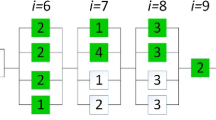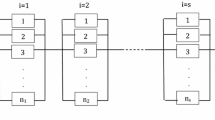Abstract
The redundancy allocation problem (RAP) is an optimization problem for maximizing system reliability at a predetermined time. Among the several extensions of RAPs, those considering multi-state and repairable components are the closest ones to real-life availability engineering problems. However, despite their practical implications, this class of problems has not received much attention in the RAP literature. In this paper, we propose a multi-objective nonlinear mixed-integer mathematical programming to model repairable multi-state multi-objective RAPs (RMMRAPs) where a series of parallel systems experiencing repairs, partial failures, and component degrading through time is considered. The performance of a component depends on its state and may decrease/increase due to minor and major failures/repairs which are modeled by a Markov process. The proposed RMMRAP allows for configuring multiple components and redundancy levels in each sub-system while evaluating multiple objectives (i.e., availability and cost). A customized version of the non-dominated sorting genetic algorithm (NSGA-II), where constraints are handled using a combination of penalty functions and modification strategies, is introduced to solve the proposed RMMRAP. The performance of the proposed NSGA-II and that of an exact multi-objective mathematical solution procedure, known as the epsilon-constraint method, are compared on several benchmark RMMRAP instances. The results obtained show the relative dominance of the proposed customized NSGA-II over the epsilon-constraint method.






Similar content being viewed by others
References
Agarwal M, Gupta R (2006) Genetic search for redundancy optimization in complex systems. J Qual Maint Eng 12(4):338–353
Chern MS (1992) On the computational complexity of reliability redundancy allocation in a series system. Oper Res Lett 11(5):309–315
Coit DW, Smith AE (1996) Solving the redundancy allocation problem using a combined neural network/genetic algorithm approach. Comput Oper Res 23(6):515–526
Deb K, Pratap A, Agarwal S, Meyarivan TA (2002) A fast and elitist multi-objective genetic algorithm: NSGA-II. IEEE Trans Evol Comput 6(2):182–197
Garg H, Sharma SP (2013) Multi-objective reliability-redundancy allocation problem using particle swarm optimization. Comput Ind Eng 64(1):247–255
Hwang CL, Masud ASM (1983) Multiple objective decision making methods and applications. Springer, New York
Khalili-Damghani K, Amiri M (2012) Solving binary-state multi-objective reliability redundancy allocation series-parallel problem using efficient epsilon-constraint, multi-start partial bound enumeration algorithm, and DEA. Reliab Eng Syst Saf 103:35–44
Khalili-Damghani K, Tavana M, Sadi-Nezhad S (2012) An integrated multi-objective framework for solving multi-period project selection problems. Appl Math Comput 219(6):3122–3138
Khalili-Damghani K, Tavana M, Abtahi AR (2013) A new multi-objective particle swarm optimization method for solving reliability redundancy allocation problems. Reliab Eng Syst Saf 111:58–75
Kuo W, Zuo MJ (2003) Optimal reliability modeling: principles and applications. Wiley, Hoboken
Li Z, Liao H, Coit DW (2009) A two-stage approach for multi-objective decision making with applications to system reliability optimization. Reliab Eng Syst Saf 94(10):1585–1592
Liang YC, Lo MH (2012) A variable neighborhood search algorithm with novel archive update strategies for redundancy allocation problems. Eng Optim 44(3):289–303
Liang YC, Smith E (2004) An ant colony optimization algorithm for the redundancy allocation problem (RAP). IEEE Trans Reliab 53(3):417–423
Lisnianski A, Levitin G (2003) Multi-state system reliability assessment, optimization and applications. World Scientific, Singapore
Mavrotas G (2009) Effective implementation of the ε-constraint method in multi-objective mathematical programming problems. Appl Math Comput 213(2):455–465
Misra KB, Ljubojevic MD (1973) Optimal reliability design of a system: a new look. IEEE Trans Reliab 22(5):255–258
Mousavi SM, Alikar N, Niaki STA, Bahreininejad A (2015) Two tuned multi-objective meta-heuristic algorithms for solving a fuzzy multi-state redundancy allocation problem under discount strategies. Appl Math Model 39(22):6968–6989
Mousavi SM, Alikar N, Niaki STA, Bahreininejad A (2015) Optimizing a location allocation-inventory problem in a two-echelon supply chain network: a modified fruit fly optimization algorithm. Comput Ind Eng 87:543–560
Mousavi SM, Alikar N, Niaki STA (2016) An improved fruit fly optimization algorithm to solve the homogeneous fuzzy series-parallel redundancy allocation problem under discount strategies. Soft Comput 20(6):2281–2307
Onishi J, Kimura S, James RJW, Nakagawa Y (2007) Solving the redundancy allocation problem with a mix of components using the improved surrogate constraint method. IEEE Trans Reliab 56(1):94–101
Ramirez-Marquez JE, Coit DW, Konak A (2004) Redundancy allocation for series-parallel systems using a max-min approach. IIE Trans 36(9):891–898
Safari J (2012) Multi-objective reliability optimization of series-parallel systems with a choice of redundancy strategies. Reliab Eng Syst Saf 108:10–20
Safari J, Tavakkoli-Moghaddam R (2010) A redundancy allocation problem with the choice of redundancy strategies by a memetic algorithm. J Ind Eng Int 6(11):6–16
Sheikhalishahi M, Ebrahimipour V, Shiri H, Zaman H, Jeihoonian M (2013) A hybrid GA–PSO approach for reliability optimization in redundancy allocation problem. Int J Adv Manuf Technol 68(1–4):317–338
Tavakkoli-Moghaddam R, Safari J, Sassani F (2008) Reliability optimization of series-parallel systems with a choice of redundancy strategies using a genetic algorithm. Reliab Eng Syst Saf 93:550–556
Tavana M, Khalili-Damghani K, Abtahi AR (2013) A new variant of fuzzy multi-choice knapsack for project selection problem. Ann Oper Res 206(1):449–483
Tavana M, Abtahi AR, Khalili-Damghani K (2014) A new multi-objective multi-mode model for solving preemptive time–cost–quality trade-off project scheduling problems. Exp Syst Appl 41(4):1830–1846
Yu X, Gen M (2010) Introduction to evolutionary algorithms. Springer, London
Zhao JH, Liu Z, Dao MT (2007) Reliability optimization using multiobjective ant colony system approaches. Reliab Eng Syst Saf 92:109–120
Zio E (2009) Reliability engineering: old problems and new challenges. Reliab Eng Syst Saf 94:125–141
Acknowledgements
The authors would like to thank the anonymous reviewers and the editor for their insightful comments and suggestions.
Author information
Authors and Affiliations
Corresponding author
Rights and permissions
About this article
Cite this article
Tavana, M., Khalili-Damghani, K., Di Caprio, D. et al. An evolutionary computation approach to solving repairable multi-state multi-objective redundancy allocation problems. Neural Comput & Applic 30, 127–139 (2018). https://doi.org/10.1007/s00521-016-2676-y
Received:
Accepted:
Published:
Issue Date:
DOI: https://doi.org/10.1007/s00521-016-2676-y




